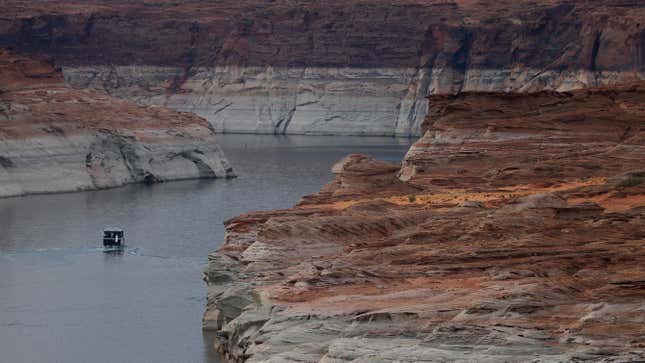
Thanks to dwindling water levels brought on by megadrought, there’s a one-in-three chance Lake Powell will drop below a critical threshold in the coming years. If it does, it would curtail hydropower generation at the second-largest reservoir in the West.
Lake Powell has already dipped to its lowest level on record as the West has been gripped by a megadrought. Projections from the Bureau of Reclamation show things could get even more dire in the coming years, which would impact millions across the West. At full capacity, the Glen Canyon Dam that holds back Lake Powell generates enough hydroelectricity to power 5.8 million households and businesses in the West.
But to keep the turbines turning, Lake Powell’s water elevation must sit at or above 3,490 feet (1,064 meters). There’s a 3% chance that it will drop below that threshold next year, and a stunning 34% likelihood that it will do so in 2023.
“The latest outlook for Lake Powell is troubling,” said the Bureau of Reclamation’s Upper Colorado Basin Regional Director Wayne Pullan in a statement. “This highlights the importance of continuing to work collaboratively with the basin states, tribes, and other partners toward solutions.”
Nearby, Lake Mead—the nation’s single largest reservoir—is also under siege. In June, the lake fell to its lowest level since the 1930s. The Bureau projects that there is a 66% chance that Lake Mead could drop below 1,025 feet (312 meters) in 2025. That’s a critical threshold that would trigger a Tier 3 water shortage, which would result in severe water restrictions for millions of residents in Western states and Mexico. The drought has already shutter hydropower generation at at least one dam in California, leading the state to fire up five temporary natural gas plants to make up for the shortage. That will increase carbon and methane emissions.
The Lake Powell figures come one month after the USBR emergency releases of water from reservoirs upstream on the Colorado River in an effort to keep Lake Powell full enough to continue generating electricity. Last month, officials also declared the first-ever water shortage for the Colorado River, triggering cuts in water usage that largely affected Arizona farmers. Dropping water levels don’t just threaten hydropower generation. They also imperil access to drinking water for the 40 million people who depend on the Colorado River and the ecosystems throughout the seven states in its basin.
A number of factors have fueled this Western water crisis. One is the overallocation of the Colorado River, and another is an inefficient use of water that has prioritized industry over ordinary people. (Native people have gotten the shortest end of that stick.) Population growth and unabated urban development in the arid West have put further pressure on water supplies. Crucially, the climate crisis has also played a major role. The West has been in a state of climate-change-fueled megadrought for decades.
“We built this system as a system of abundance. We thought that whenever we ran out of water, we could just tap another river, another lake, another place, or the system would produce enough water to meet our needs,” Newsha Ajami, the director of Urban Water Policy at Stanford University’s Water in the West program, told Earther in July. “The reality is that we’re realizing there’s no such thing as abundance. Climate change is exacerbating the problems that the system has.”